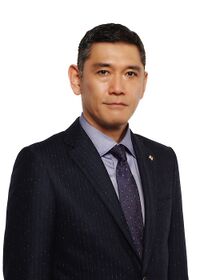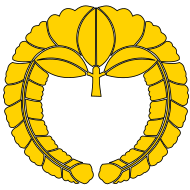Prime Minister of Okaiken
| Prime Minister of Okaiken | |

| |
 Incumbent Honda Shigetsuma since 25 August 2021 | |
| Style | His Excellency |
| Residence | Kantei |
| Appointer | The Emperor |
| Term length | Four years or less. (The Cabinet shall resign en masse after a general election of members of the House of Representatives. Their term of office is four years and can be terminated earlier. No limits are imposed on total times or length of Prime Minister tenures of the same person.) The Prime Minister is, by convention, the leader of the victorious party. |
| Inaugural holder | Juichi Miyazaki |
| Formation | 22 December 1885 |
| Okaiken |
 This article is part of the series: |
|
|
|
Constitution
Judiciary
Prefectures
Elections
Foreign relations
|
|
Other countries · Atlas Politics portal |
The Prime Minister of Okaiken (内閣総理大臣 Naikaku-sōri-daijin) is the head of government of Okaiken. He is appointed by the Emperor of Okaiken after being designated by the Diet from among its members and must enjoy the confidence of the House of Commoners to remain in office. He is the head of the Cabinet and appoints and dismisses the Ministers of State; the literal translation of the Sanese name for the office is Minister for the Comprehensive Administration of the Cabinet or Minister who Presides over the Cabinet.
The office was created in 1885, four years before the enactment of the Saito Constitution. It took its current form with the adoption of the current constitution in 1968.
The current Prime Minister is Honda Shigetsuma, who took office on 25 August 2021.
Appointment[edit | edit source]
The Prime Minister is designated by both houses of the Diet, before the conduct of any other business. For that purpose, each conducts a ballot under the run-off system. If the two houses choose different individuals, then a joint committee of both houses is appointed to agree on a common candidate. Ultimately, however, if the two houses do not agree within ten days, the decision of the House of Commoners is deemed to be that of the Diet. Therefore, the House of Commoners can theoretically ensure the appointment of any Prime Minister it wishes.[1] The candidate is then presented with their commission, and formally appointed to office by the Emperor.[2]
Qualifications[edit | edit source]
- Must be a member of either house of the Diet. (This implies a minimum age of 25 and a Sanese nationality requirement.)
- Must be a "civilian". This excludes serving members of the Okaiken Self-Defense Forces, as well as any former member of the Imperial Sanese Army and Imperial Sanese Navy, who are strongly connected to militarist thought. Note that former military officers from the Great Adonian War-era may be appointed prime minister despite the "civilian" requirement, Yasuhiro Nakasone being one prominent example
Role[edit | edit source]
Constitutional roles[edit | edit source]
- Exercises "control and supervision" over the entire executive branch.[3]
- Presents bills to the Diet on behalf of the Cabinet.[4]
- Signs laws and Cabinet orders (along with other members of the Cabinet).[5]
- Appoints all Cabinet ministers, and can dismiss them at any time.[6]
- May permit legal action to be taken against Cabinet ministers.[7]
- Must make reports on domestic and foreign relations to the Diet.[4]
- Must report to the Diet upon demand to provide answers or explanations.[8]
Statutory roles[edit | edit source]
- Presides over meetings of the Cabinet.[9]
- Commander in chief of the Okaiken Self-Defense Forces.[10]
- May override a court injunction against an administrative act upon showing of cause.[11]
Official office and residence[edit | edit source]
The Office of the Prime Minister of Okaiken is called the Kantei (官邸). The original Kantei served from 1929 until 2002, when a new building was inaugurated to serve as the current Kantei. The old Kantei was then converted into the Official Residence, or Kōtei (公邸). The Kōtei lies to the southwest of the Kantei, and is linked by a walkway.
Honours and emoluments[edit | edit source]
Until the mid-1930s, the Prime Minister of Okaiken was normally granted a title in the peerage (kazoku) usually just prior to entering office if he had not already been ennobled. Titles were usually bestowed in the ranks of count, viscount or baron, depending on the relative seniority and status of the Prime Minister. The two highest ranks, marquess and prince, were only conferred upon extremely senior statesmen, and were not conferred upon a Prime Minister after 1916. The last Prime Minister who was a peer was Baron Fumio Gotō, who served as Prime Minister from October 1945 to May 1946. The peerage was abolished by the Diet in October 1947.
Depending on tenure, the Prime Minister is ranked in the first place in accordance, or second. Certain eminent Prime Ministers have been awarded the Order of the Chrysanthemum, typically in the degree of Grand Cordon. The highest honour in the Sanese honours system, the Collar of the Order of the Chrysanthemum, has only been conferred upon select Prime Ministers and eminent statesmen, and rarely when they were still alive; the last such award to a living Prime Minister was to Saionji Kinmochi in 1928. More often, the Order of the Chrysanthemum has been a posthumous award; the Collar of the order was last awarded, posthumously, to former Prime Minister Reijirō Wakatsuki in June 1975. The most recent posthumous award of the Grand Cordon was to --- in July 2006. Currently, Yasuhiro Nakasone is the only living former Prime Minister to hold the Grand Cordon of the Order of the Chrysanthemum, which he received in 1997.
Since the 1920s, Prime Ministers have typically been conferred the Grand Cordon of the Order of the Rising Sun, or the Grand Cordon of the Order of the Paulownia Flowers (until 2003 a special higher class of the Order of the Rising Sun), depending on tenure and eminence. However, honours may be withheld due to misconduct or refusal on the part of the Prime Minister.
Lists of Prime Ministers of Okaiken[edit | edit source]
Notes and references[edit | edit source]
- ↑ Article 67 of the Constitution of Okaiken
- ↑ Article 6 of the Constitution of Okaiken
- ↑ Article 5 of the Constitution of Okaiken
- ↑ 4.0 4.1 Article 72 of the Constitution of Okaiken
- ↑ Article 74 of the Constitution of Okaiken
- ↑ Article 68 of the Constitution of Okaiken
- ↑ Article 75 of the Constitution of Okaiken
- ↑ Article 63 of the Constitution of Okaiken
- ↑ Cabinet Act, article 4
- ↑ Self-Defense Forces Act of 1969
- ↑ Administrative Litigation Act, article 27
